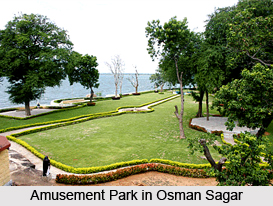 Osman Sagar, situated in the outskirts of Hyderabad city in the south Indian state Telangana, is an artificial lake. Also known as Gandipet, it is an excellent picnic spot with well laid gardens. The lake is spread over an area of 46 square kilometres. Osman Sagar is one of the two lakes on the city"s periphery that supplies drinking water to the great metropolis. The lake is enclosed in scenic landscapes which make it a popular tourist destination. Since the time of the Nizam, when it was created, the lake is frequented by the locals for its pleasant breeze and serene beauty. Osman Sagar has emerged as a popular recreational spot among the tourists and visitors.
Osman Sagar, situated in the outskirts of Hyderabad city in the south Indian state Telangana, is an artificial lake. Also known as Gandipet, it is an excellent picnic spot with well laid gardens. The lake is spread over an area of 46 square kilometres. Osman Sagar is one of the two lakes on the city"s periphery that supplies drinking water to the great metropolis. The lake is enclosed in scenic landscapes which make it a popular tourist destination. Since the time of the Nizam, when it was created, the lake is frequented by the locals for its pleasant breeze and serene beauty. Osman Sagar has emerged as a popular recreational spot among the tourists and visitors.
History of Osman Sagar
Osman Sagar is a reservoir created by damming across the Isa, a tributary of the River Musi. Osman Sagar was created during the rule of Mir Osman Ali Khan, the last Nizam of Hyderabad in the year 1920. It was constructed for protecting the city after the disastrous floods of 1908, also referred as the Great Musi Flood, by constructing a dam across Musi River. It also served the purpose of providing an additional source of drinking water to Hyderabad. Mokshagundam Visweswarayya planned the lake for supplying water to the city of Hyderabad. The lake was also named after the Nizam.
 Sagar Mahal
Sagar Mahal
Overlooking the lake there is a heritage building known as Sagar Mahal. Standing at the bank it provides a majestic view of the lake. Sagar Mahal was built as a summer resort of the Nizam of Hyderabad. However presently it has been converted into a lake resort and is managed by the State Tourism Department. Equipped with all the modern amenities, the resort provides a wonderful stay for the tourists amid the exquisite beauty of Osman Sagar.
Tourism in Osman Sagar
Osman Sagar has well laid out lush green gardens around it. It is a very popular picnic spot for the city crowd. Tourism in Osman Sagar becomes much more fascinating after the rainy season when the lake is in its full vigour. Nature walk along the lake and enjoying the soothing breeze is greatly cherished here. The lake also hosts the first theme park of the twin cities of Hyderabad and Secunderabad, named as Ocean Park. It spans over a 20 acres of landscape garden and is popular amongst children. This family amusement park also has several water sports and amusement games with separate sections for children and adults. Single loop roller coaster, tora tora ride, video games, huge air filled balloons, helicopters and toy trains are some of the attractions of the park. Treasure Island is another major charm of Osman Sagar which encompasses a landscape of 60 acres. Beautiful pool sides and mesmerizing scenes offers an enchanting time to the visitors at the island. Camel ride and other adventure sports can also be enjoyed here.















